Expert’s Rating
Pros
- Premium build with aluminium frame
- Speedy Snapdragon 8s Gen 4 processor
- Massive 6500mAh battery
- 90W fast charging with charger in box
Cons
- No telephoto camera
- No eSIM or wireless charging
- Some bloatware to deal with
Our Verdict
The Poco F7 delivers a flagship-level gaming experience at a fraction of the cost. It has a gorgeous screen, premium look and feel, massive battery and speedy charging. The cameras are good, but without a telephoto camera, the system is more limited than some of its competition. However, when it comes to pure performance, few phones in this price bracket will be able to keep up with the speedy F7.
Price When Reviewed
This value will show the geolocated pricing text for product undefined
Best Pricing Today
A few months back, Poco launched the F7 Pro and the F7 Ultra. They’re both seriously powerful phones at incredibly affordable price points, but the standard F7 was oddly missing from the lineup.
I was beginning to think the brand may forego a standard model this time around, but it has finally arrived, and now that we know what’s inside it, the delay starts to make a little more sense: This is one of the first phones to feature the brand new Qualcomm Snapdragon 8s Gen 4 processor.
If you’re not quite up to speed with Qualcomm’s naming conventions, this chip is essentially one step down from the almighty 8 Elite, but a massive leap ahead of the 7-series processors. Crucially, it’s much more affordable, so it can be found in cheaper smartphones, like the F7.
It’s not all about the processor, though. This phone has a massive battery, speedy charging, a slick design and a gorgeous display. On first impressions, it seems like a bit of a bargain. I wanted to see if that’s the case, so I slipped my SIM card in, and a week later, here’s what I learned.
Design & Build
- Aluminium frame, plastic back
- 216g, Corning Gorilla Glass 7i
- IP68 water and dust resistance
The Poco F7 is available in three colourways, and somewhat unusually, I’ve managed to get my mitts on all three options to showcase in this review. As standard, there’s a black version and a white version, which both have two-tone designs split with a diagonal line down the rear panel. The upper portion has a more matt finish, while the lower portion is more glossy.
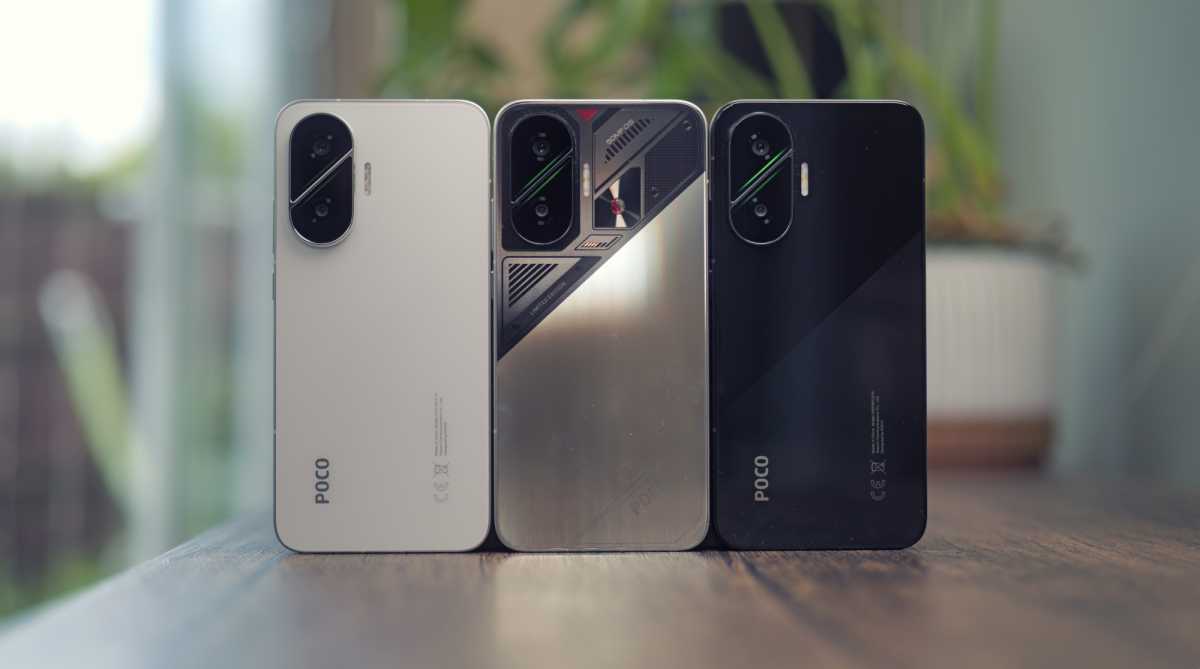
Luke Baker
There’s also a special limited edition silver version, which makes a bit more of a statement. It’s black on top, with embossed elements that give it the appearance of a semi-transparent design, and glossy silver on the bottom portion. It’s the most gamer-looking model in the lineup, which might divide opinion, but I think it looks great.
All three variants have aluminium side rails and plastic rear panels. However, at a glance, the rear looks a lot like glass.
All three variants have aluminium side rails and plastic rear panels. However, at a glance, the rear looks a lot like glass. The only real giveaway is that the darker colours are a little more smudge-prone than usual.
Overall, the phone feels pretty premium, and I think the aluminium side rails are the main reason for that. That said, it should be fairly durable, with Corning Gorilla Glass 7i coating the screen and a flagship-level IP68 certification for dust and water resistance.
It’s a pretty big phone, with a 6.83-inch display, and the boxy iPhone-like design means it feels substantial in the hand. I found it perfectly comfortable to use, but I have big hands; those with smaller paws might have a more difficult time.
Screen & Speakers
- 6.83-inch, 2772 x 1280, OLED, 120Hz
- 3200 nits peak brightness
- Stereo speakers
The Poco F7 has a large, fully flat display, which is luxurious for watching content and playing games. It’s well specced, too. It’s an OLED panel with a speedy 120Hz refresh rate and an ample 2770 x 1280 resolution.

Luke Baker
The screen has a slim, even bezel on all sides, which immediately gives the handset a more premium look than some of the competition.
It’s a very bright panel, too, boosting up to 3200 nits in certain scenarios. This means you’ll never have trouble seeing it outdoors, and HDR content from Netflix and YouTube looks incredibly dynamic.
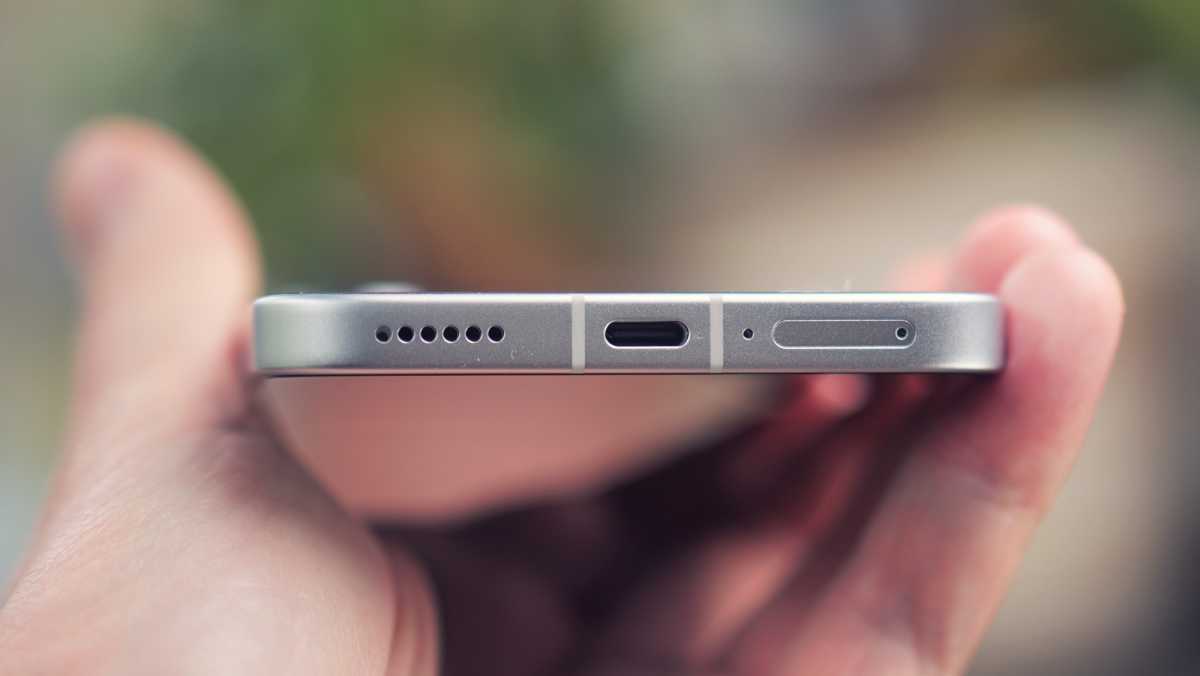
Luke Baker
The phone has dual stereo speakers. One speaker fires from the base, next to the USB-C port, while the other doubles up as the phone’s earpiece. I’m always happy to see stereo speakers on mid-range handsets; it’s an easy way for manufacturers to cut costs, but it makes a significant difference to the listening experience, and it’s especially important when you’re gaming without a headset.
You’ll never have trouble seeing it outdoors, and HDR content from Netflix and YouTube looks incredibly dynamic
They sound pretty great, too. The phone kicks out more volume than most, with lots of clarity and very little distortion. As usual, it’s the bass that’s lacking a little, but it’s still decidedly above average. They’re more than good enough for playing games and watching content around the house.
Specs & Performance
- Qualcomm Snapdragon 8s Gen 4
- 12GB RAM
- 512GB storage
As mentioned in the intro, the Poco F7 is one of the first devices to land with the Qualcomm Snapdragon 8s Gen 4 inside. Slightly confusing naming aside, it should be a little slower than the 8 Elite and faster than the previous-gen flagship, the 8 Gen 3.

Luke Baker
In most benchmarks, that’s exactly what I saw. I got some slightly odd results with GFXBench, but that has been known to happen from time to time. Crucially, the Poco F7 was able to outpace the Samsung Galaxy S24 in Geekbench and 3DMark Wildlife Extreme – pretty impressive stuff for a phone this cheap.
Of course, the impressive performance isn’t constrained to synthetic benchmarks. This phone will run just about any game you can throw at it with the settings maxed out.
This phone will run just about any game you can throw at it with the settings maxed out
It does get hot after a while, but I was testing during the hottest week of the year so far, so that’s to be expected. Slipping on the included TPU case does a good job of keeping that heat away from your palms.

Luke Baker
My test unit came equipped with 12GB of RAM and 512GB of storage, which is the more premium option; the base model comes equipped with 12GB + 256GB. Even without expandable storage, both models offer plenty for most people’s needs, and the phone multitasks like a champ.
I won’t go into too much detail about the gaming options, as they seem to be identical to all recent Poco devices, but there are plenty of options to tweak if you want to push the performance further.
I also like that there’s a game launcher, a lot like the one on Redmagic devices, which can make your phone feel a bit more like a handheld gaming device than a phone, especially when paired with a clamp-on controller like the Gamesir X2 Pro.
Poco F7 benchmarks
Cameras
- 50Mp f/1.5 main camera
- 8Mp f/2.2 ultrawide
- 20Mp f/2.2 selfie camera
The Poco F7 camera system nets you a really solid main camera, a pretty mediocre ultrawide and a decent selfie snapper.

Luke Baker
It’s not as well-rounded as some of its competitors, but it doesn’t need to be. While others put photography at the forefront, the Poco F7 is all about performance, and as we’ve seen, it delivers that in spades.
That said, the F7 cameras still outperform most gaming-centric phones. Xiaomi knows what it’s doing when it comes to image processing, and despite middling specs, the result I got from these cameras outshone anything I have achieved with a Redmagic or Asus ROG device.
Regardless of lighting conditions, you’ll want to stick to the main camera as much as possible. The quality is noticeably higher, and it resolves much finer details than the other two lenses. When it’s dark out, the difference becomes even more apparent. Still, the ultrawide has its uses, and I’d rather have a mediocre wide lens than none at all.
Poco F7 camera system nets you a really solid main camera, a pretty mediocre ultrawide and a decent selfie snapper
The selfie camera does a good job in all lighting conditions, and I was surprised by the lack of motion blur in low-light shots, which is a common problem with competing devices. Portrait mode cutouts are solid, too. However, the portrait processing is a little heavy-handed on the rear camera, even with beauty mode turned off.
For video shooting, you can capture at up to 4K at 60fps, but only on the main rear camera. The other two lenses max out at 1080p. Stabilisation is very good, but the microphones are quite susceptible to wind noise, so you’ll need to be careful when shooting outdoors.
Battery Life & Charging
- 6500mAh battery
- 90W wired charging
- 22.5W reverse wired charging
One of the standout features of this phone is the massive 6500mAh battery. That’s an astonishing capacity, and significantly larger than most flagship phones. The fact that Xiaomi can include it on such an affordable handset has me very excited about future devices – maybe 10,000mAh in a pocketable phone is closer than we think.
One of the standout features of this phone is the massive 6500mAh battery
That said, the actual performance was a little underwhelming. Don’t get me wrong, it’s a very solid battery, and I could manage two days on a charge without issue – but I have been able to do the same with 5500mAh cells, too. Perhaps the OS needs longer to learn my habits and further optimise things.
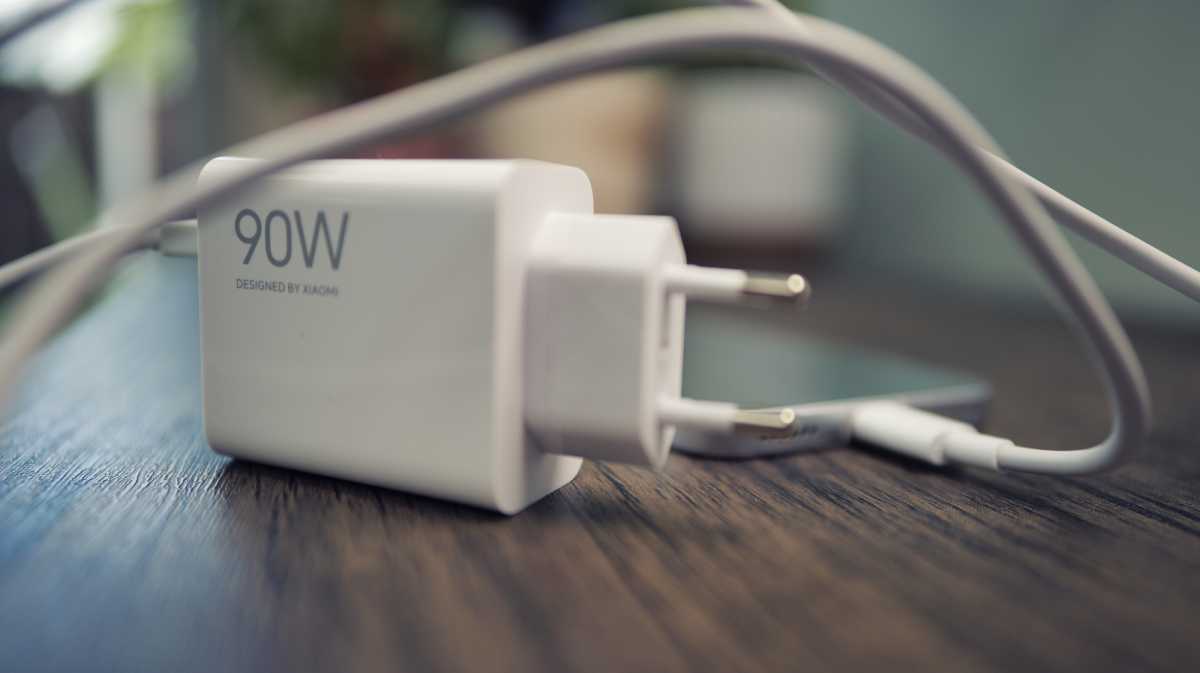
Luke Baker
Our usual PCMark battery drain test gave a score of 14 hours and 44 minutes, which is almost exactly the same as the Poco F7 Ultra (which only has a 5300mAh battery). So it’s not just my imagination – Xiaomi clearly needs to do some tweaking to get the most from this huge battery.
When it’s time to charge, the phone supports wired charging at up to 90W, and that speedy charger comes included in the box. It’s enough to take you from fully drained to almost 80% charged in just half an hour, so it’s super convenient.
There’s no wireless charging, but given the price, that shouldn’t come as too much of a surprise.
Software & Apps
- Hyper OS 2, based on Android 15
- HyperAI features
- Some bloatware to deal with
The Poco F7 runs Hyper OS 2, the same software you’ll find on all recent Xiaomi and Poco devices. It’s a heavily customised version of Android 15, which some love, and others find hard to adapt to. It’s not my favourite OS by default, but it’s very customisable, and with some tweaking, you can get it to look and behave however you like.
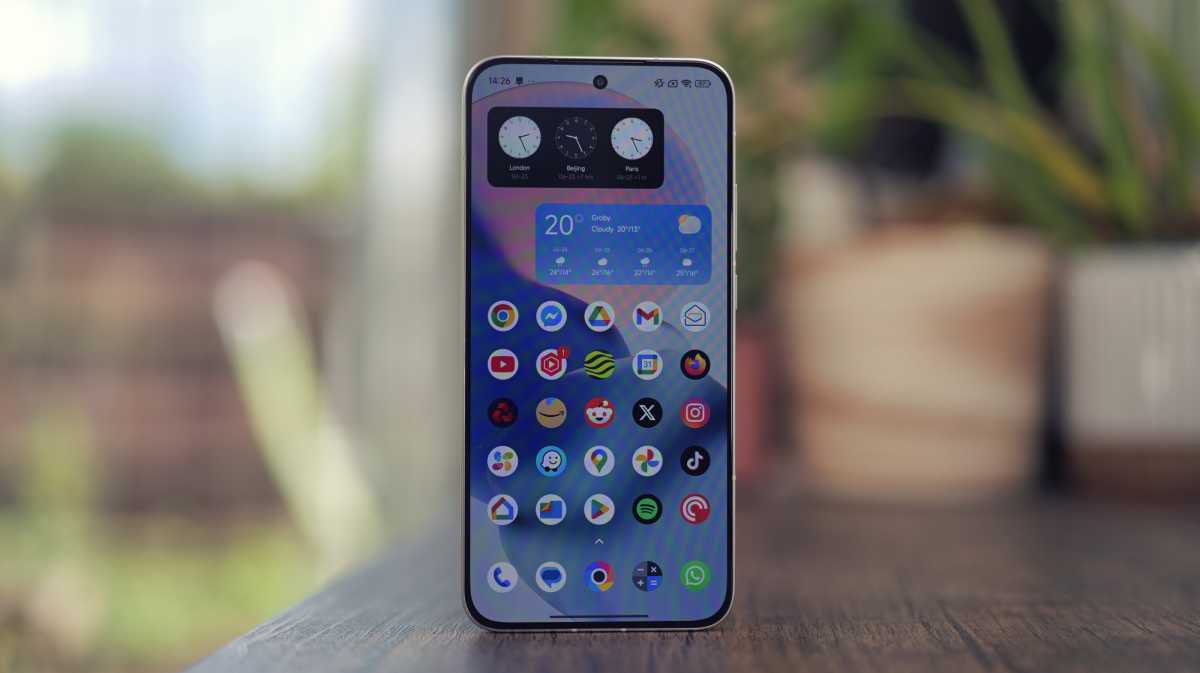
Luke Baker
You get all of the usual Google features like Gemini and Circle to Search, but Xiaomi has its own suite of AI features, too. It’s mostly the kind of stuff we’ve come to expect, like translation tools, a writing assistant and AI summarisation, but there are also some nifty image editing tools, like an AI object eraser, image expander and an image enhancer.
The OS feels very quick and snappy, which is partially due to the horsepower under the hood, but the animation style makes it feel quicker still
The OS feels very quick and snappy, which is partially due to the horsepower under the hood, but the animation style makes it feel quicker still. You’re never left waiting long, and you’ll rarely see stutters, it’s a smooth, speedy experience.
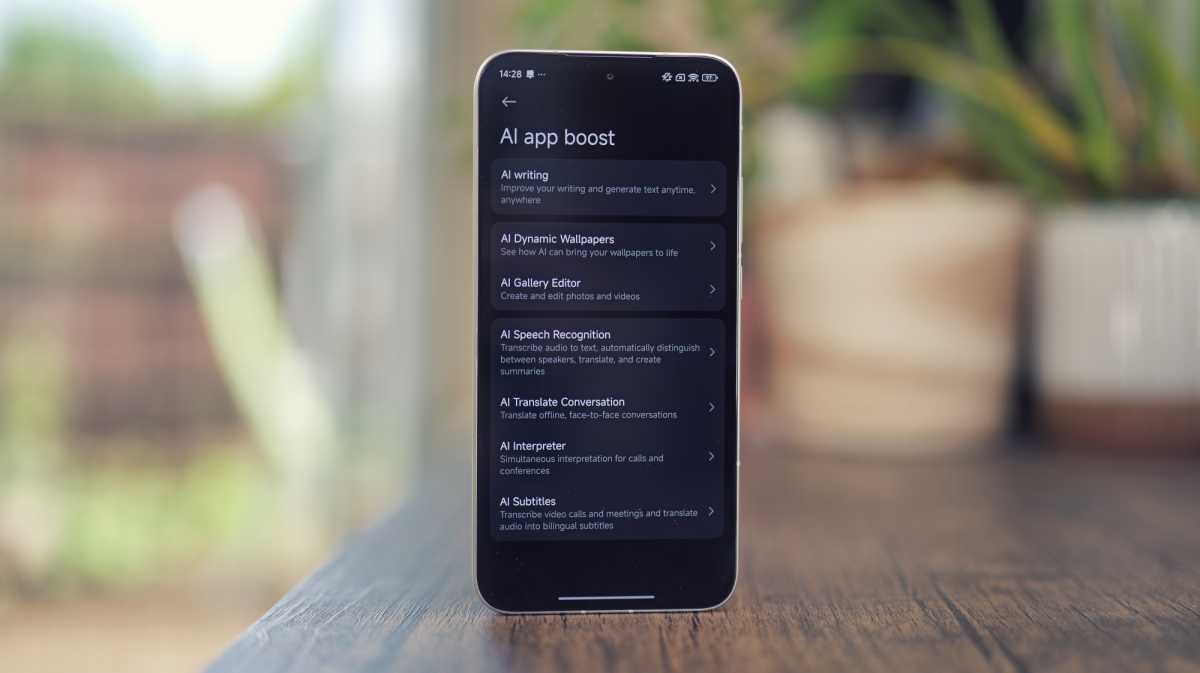
Luke Baker
The biggest downside is the amount of bloatware that comes pre-installed. Yes, this is an affordable device, and bloat often comes with the territory, but there’s a considerable amount here, including all kinds of random games. Most of it can be uninstalled, but it detracts from the experience of setting up your new device.
Price & Availability
The Poco F7 is available to order now in the UK and Europe, but as usual, it won’t be launching in the States. The base model, with 12GB of RAM and 256GB of storage, will cost you £389, while the 512GB version will set you back £429
That said, if you get in early, you can nab this phone for just £319 or £359 in the UK for a limited time from the Xiaomi website. So, if you’re keen on this handset, it’s worth acting fast.
The pricing puts the Poco F7 up against devices like the Google Pixel 9a, Nothing Phone (3a) Pro and the Honor 400. Some of these mid-range rivals have the upper hand when it comes to photography, but when it comes to performance and gaming, the F7 is clearly a big step ahead.
Should you buy the Poco F7?
If you’re looking for a sub-£400 phone that can handle some serious gaming, the Poco F7 is hard to beat. It performs on par with some of the most powerful flagships from last year, while delivering a stunning screen, massive battery, quick charging and a standout design.
It’s only the camera system that falls slightly behind some of its similarly priced competition. That’s not to say the cameras are bad – they’re actually very capable – but without a dedicated telephoto, the system is less versatile than some of the competition.
Of course, at this price, you can’t have everything, and Poco has clearly prioritised performance. However, unlike dedicated gaming handsets, the spec sheet is nicely balanced, and you don’t have to make many concessions elsewhere.
The Poco F7 has been a pleasure to live with, and if you’re seeking top performance at an affordable price, you won’t be disappointed with this one.
Specs
- Hyper OS 2, based on Android 15
- 6.83-inch, 2772 x 1280, OLED, 120Hz
- Optical in-display fingerprint sensor
- Qualcomm Snapdragon 8s Gen 4
- 12GB RAM
- 256GB / 512GB storage
- Camera:
- 50Mp main sensor
- 8Mp ultrawide
- 20Mp selfie camera
- Up to 4K @ 60fps rear video
- Stereo speakers
- Dual-SIM
- Wi-Fi 7/6/5/4
- Bluetooth 6
- 6500mAh battery
- 90W wired charging
- 163.1 x 77.9 x 8.2 mm
- IP68 certified
- 216g
- Colours: Black / Silver / White


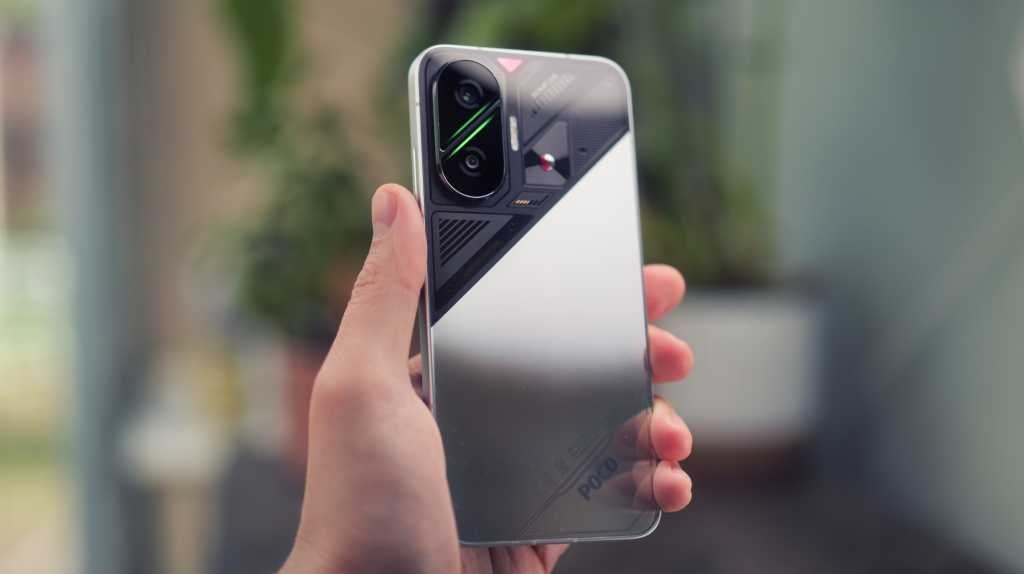











Leave a Reply